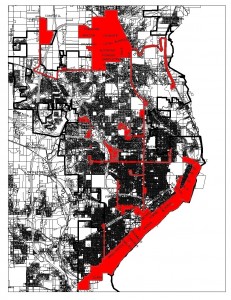If you watch or attend Peoria City Council meetings, you’ve probably seen Roger Sparks. He’s on the Mayor’s Advisory Committee for the Disabled. He is a person with a disability. And now he’s suing the City for non-compliance with the Illinois Accessibility Code, the Environmental Barrier Act, and the Americans with Disabilities Act.
The lawsuit has been filed in United States District Court, Central District of Illinois. Sparks has been agitating for ADA compliance in the City for years, but to no avail from what I can tell reading the complaint. The first part of the complaint states violations regarding Peoria City Hall: no directional signage indicating the nearest accessible entrance, no accessible public men’s room after hours, public service counters are too high (above 34 inches), and several violations in council chambers (Room 400).
But that’s not all. Sparks has additional complaints (incidentally, he filed in forma pauperis, which essentially means he’s acting as his own lawyer, so much of the complaint is in first person):
The City of Peoria does not comply with ramp transitions to walks, gutters, or streets, as most curb cuts within the City of Peoria are not flush and free of abrupt changes. Sections of sidewalks within the City of have height differences of 1/2 inch or more. Others sidewalks are left to deteriorate and cannot be use by a person in a wheelchair. I have had to exit a bus on a sidewalk only to enter the street in front of the bus using a traffic lane to get to the intersection and cross the street as some curb cuts are blocked by
obstacles. I have had to drive my wheelchair down lanes of traffic, as there are no sidewalks in some areas of Peoria. Several intersections within the City of Peoria have raised islands with no cut through level with the street or have curb ramps at both sides.During winter months the City of Peoria plows in bus stops and curb cuts making them inaccessible to myself. The City of Peoria does not require sidewalks to be cleared.
The City of Peoria has revised Chapter 17 of its code, Article II Fair Employment and Housing with ordinance No. 15,889[…]. This ordinance has denied me the right to file a housing complaint against my landlord with the City of Peoria. The City of Peoria will not investigate discrimination of state, or United States laws.
The City of Peoria refuses to comply with Section 35.105 self-evaluation of the American with Disabilities Act. As I have requested a copy several times.
Ordinance 15,889 denies me the right to file discrimination complaints with the City of Peoria against businesses having violations from City of Peoria codes, ordinances, the Environment Barrier Act, the Illinois Accessibility Code when altering their parking lots, in their Zoning Certificates, and allowing these businesses to obtain special use permits not only once but twice while having these violations. The City of Peoria even moves or extends Enterprise Zones to give these businesses sales tax exemptions while having these violations.
When businesses are required to install sidewalks according to city code. The City of Peoria issues sidewalk and other variances not in the best interest of the public.
So, what does he hope to get out of this lawsuit?
I am seeking relief from the City of Peoria to change their policies and procedures to inspect an properties with new construction, alterations or additions at the time of construction. To have all properties comply with they’re Zoning Certificates, the Illinois Accessibility Code, and the American with Disabilities Act.
I am seeking a monetary settlement of $500,000.00
I don’t know how the suit will turn out, but I can tell you this — it’s difficult for a person without a disability to get around Peoria as a pedestrian. Sidewalks are intermittent, often crumbling and/or obstructed, and completely useless in the winter. If you’re in a wheelchair, it’s another order of magnitude more difficult. WHOI News even did an investigative report on it, back when they were an independent news organization.
If Mr. Sparks can win the non-monetary relief for which he’s asking, it will be a benefit to all Peorians.

